Oh, the days, they waste away, like an unplayed game.
And the hours succumb to torment’s playThe time rises and falls
Slipping softly through me,
As I sing the old songs,
Knowing only the beginning.And no child could follow her predestined path more dreamily
And no old man could know how long life is more certainly.But sorrow will not silence
Old dreams or young wisdom.
Nor will it make me give up on
The beautiful pure joy of life.-Hannah Arendt
Waiting around to die
Recently, I was talking to someone I love who was in the throes of addiction. At least two voices were coming out of one mouth, sometimes alternating in rapid succession. The loudest voice was the raging, paranoid, wheedling, conniving, hungry voice of addiction. I didn’t know how to feel about that voice – I felt like though I got where it was coming from, but I really really didn’t like it.
But I loved the person it was coming out of. And I felt like I was fishing, dangling a line, to pull out the other, fainter voice, the voice of the person I knew that was everything else that wasn’t the ravenous need of the addiction. Whose reasoning was sound, whose logic wasn’t distorted.
When what you see are the actions, and what you mostly hear are the words of the tricksy con-artist fueled by desperate craving, it’s hard to separate the person from the demonic spirit they seem possessed by. And I think this is one reason we often treat people struggling with addiction as undeserving of personhood. I was looking for ways to hold on to the person I knew, the person who seemed to be engulfed, mostly, at least for the moment. I was struggling to hold them in personhood.
I also felt a sense of panic when the voice of addiction was showing up in the place of the reasonable person I wanted to talk to. It’s a panic common to situations when you encounter someone you think you know well and they don’t behave the way you expect them to. Because you think you know them well, you are confident that this person will interact with you in a way that you associate with them reliably being themselves. The solidity of your world depends on them being themselves. And then that person doesn’t seem to be inhabiting that familiar body. They don’t show up the way you expect them to show up. You feel panic because your world is shaken, and anger at them for not being there when you count on them to be there.
Another situation in which we can experience this same constellation of feelings is when our loved ones develop dementia and are less and less likely to express the behaviours we used to count on. We feel we can’t reach them, and it’s harder and harder to hold them in personhood.
I’ve written before about how people who are living with dementia, or other conditions that render a person non-speaking, or unable to express the kind of linear logical reasoning we associate with being human, are in danger of losing their status as people. And when we take away that status, we also take away the possibility of relationship – we seal someone off in isolation, and then all they can do is wait around to die.
Participatory sensemaking and situated personhood
Stefanie Blain-Moraes is a biomedical engineer, musician, and rehabilitation scientist who currently holds a Canada Research Chair in Consciousness and Personhood Technology at McGill University in Montreal. Her lab uses technology to facilitate interaction with people who are behaviorally unresponsive. This may be because they are living with advanced dementia, or advanced autism, or were born with complex disabilities, or have acquired disabilities, or are children and adults in palliative care.
Blain-Moraes explains. “If you look at it at face value, there's nothing in common between these groups. However, for me, what unites them is that they all have lost the ability to intentionally engage with others. And by that, I mean that they don't move, they don't speak in ways that are meaningful to other people. What they have in common is that they are at risk of loss of personhood.”
In many ways, Blain-Moraes explains, non-communicative populations are a new phenomenon, the result of medical progress. “40 years ago we didn't have these populations because they would die before they got to this stage. We’ve gotten very good at saving lives, and we've gotten very good at sustaining lives that would not have been sustained otherwise. The part that has not kept pace with our ability to save lives is: ‘What is this life for? What makes this life worth living?’”
“Look at that question with respect to someone who's stripped of their ability to contribute to society in a financial way, to contribute their skills - where do they find meaning in life? In the end, it comes down to relationships, comes down to their capacity to be in relationship with others.
“That is the target of what we do. Feeding those relationships, creating tools to interact with others under these circumstances of minimal communication, and hopefully, infusing these lives with value and meaning. So that once we've saved a life, there is something worth living for.”
Nothing and nobody exists in this world whose very being does not presuppose a spectator. In other words, nothing that is, insofar as it appears, exists in the singular; everything that is is meant to be perceived by somebody.
-Hannah Arendt
On the topic of relationship, I give Blain-Moraes a definition of participatory sensemaking (for more on participatory sensemaking see this post): I would describe participatory sensemaking as a focus on the dynamics of relational interactions, looking at individual agents in relation to an emergent interaction process that takes on a life of its own, in continuously determining what matters. I ask her if this resonates with her.
“I love it,” she responds. “Every aspect of it resonates with me.”She continues, “The definition of personhood that I like is one that focuses on the status that's attributed to a person by virtue of their relationships and social interactions. You don't need to be conscious to have personhood. Personhood is something that's attributed to you through a relationship. But it's difficult to be in a relationship when you can't interact. When we look at what you need to be considered interactionally available, there are two core ingredients:
You need to have a sense of co-presence of the other and you need to have a sense of reciprocity with the other. If you can't respond to someone and you can't interact with someone, both of those go away. You're not perceived as someone who's interactionally available. The capacity for a relationship goes away and all of a sudden you lose your status as a person.
“I appreciate so many elements of your definition of participatory sense-making. The interpersonal interaction; the fact that it evolves over time; that it's situational and relational; that it waxes and wanes according to the actors involved, the place involved; the fact that it's emergent and more than the sum of the people, the space and the technologies present; that there is a continuous determining of what matters. I appreciate the idea of a group collective discernment of what is happening: ‘Is there someone here? What are they trying to say? What state are they in?’ There is a continuous determination of what matters. So — every aspect of that definition I love.”
Blain-Moraes has advocated for the concept of situated personhood. When asked to define this concept, she explains, “Situated personhood is contextual, it's dynamic, and an emergent process. It's also not a passive process - someone relating to another can do things to control the degree of their attributed personhood.
“(Philosopher and bioethicist) Hilde Lindemann talks about holding someone in personhood. When personhood is in danger, one can do things to hold another in personhood. For example: they can tell stories about this person to reinforce their narrative self. They can put pictures of the person living a happy moment on the hospital room wall. I have a colleague who has a son who is minimally communicative at his best, but when he's sick, he doesn't communicate at all. When he needs to get admitted to the hospital, she will put a picture of him on a raft in the middle of the lake on the top of his medical chart. She creates a sense for the medical team that, ‘This is the person you're caring for. I know that he looks like he's just a body in the bed right now, but this is the person.’
“I knew a father would buy jewelry for his daughter who was in a vegetative state and decorate her body with adornments befitting a person. Every week she would have a different bracelet.
“I knew a family who was not financially well off with a daughter who was blind and minimally communicative. On one of my visits, I noticed that an L.O.L. doll had appeared on her bedside table. These dolls have a lot of social capital in elementary school these days! They're expensive, they’re tradable, and they’re collectable, but on the surface, they are completely inappropriate for someone who has limited perception of her environment. But someone who knew this girl had felt: ‘This is an item that befits a person her age and it is worthwhile to spend money on. We will unwrap for her and gift it to her in order to hold her in personhood.’
But sometimes, Blain-Moraes continues, for practical reasons you might need to bracket the personhood – to temporarily set it aside in order to get a job done. “We were working with an elderly couple: the wife had advanced dementia and the husband was trying to get her into the car. He was elderly, had poor balance and was trying to coordinate with her to get her into the car: ‘Everything's okay, honey. We're going to bend down now. Now we need to catch you from the inside.’
“ [their daughter] was like, ‘Dad, just move her. You can't stand in that position for that long.’
“And so, for the time that it took her to get into the car, they treated her as an object. Then, the husband said, ‘Okay, honey, there we go. Now, we're going to put your seatbelt on.’ There was this temporary bracketing of personhood so that they could safely transfer her without hurting her husband in the process.”
Biomusic
As a biomedical engineer who is also trained as a musician, Blain-Moraes has created a technology she calls Biomusic as a way of facilitating relationship — the sense of co-presence and reciprocity that conveys situated personhood — between minimally communicative individuals and those who interact with them.
“I call it a technology for human relationships,” says Blain-Moraes. “It records signals from the autonomic nervous system, which reacts to emotion, stress and different mental states. Biomusic extracts physiological features related to these emotional and mental states and converts them into a musical output so you can hear, in real time, the physiological changes inside someone's body.”
Blain-Moraes continues, “We use it with partners where one person is minimally communicative. The minimally communicative person will wear the sensor and their biomusic will be broadcast to their partner. The partners will interact and hear the music changing in real time in response to their interactions.”
Naomi Askenazi, a graduate student who is using Biomusic technology in her research with children in palliative care, explains in a bit more detail: “Biomusic technology is a two-component technology comprised of a sensor that sits on the finger and a smartphone application. The sensor captures your body's physiological responses, specifically autonomic nervous system signals, and transforms that into live music or some kind of sound output.
“An example I like to give is: You could have your physiology sonified into a classical music piece where your heart rate affects the speed of the music. So if you take a couple of deep breaths, and get your breathing to slow down, you'll hear the classical music slow down as well. And then your skin conductance, or how sweaty you are, typically increases in moments of recognition and activity. If your palms start to sweat all of a sudden because someone walks into the room the music may swell. Maybe you'll start to hear layered piano. Some variations on the cello, potentially.”
Some of the Biomusic default sonifiers include jazz and an outdoor soundscape with a brook and birds. But they can also be customized. Blain-Moraes explains that people will accept them or reject them based on how well the soundscapes match someone’s perception of themselves. For example, once the team initially chose a classical music sonifier for an adolescent with autism. “While it was faithfully manifesting his physiological changes,” Blain-Moraes recounts, “He was like, ‘That's not me. That is not me.’
“’So what is you?’
“And he's like, ‘My cat is.’
“So we recorded a soundscape where the intensity of the purr of the cat was associated with the heart and different meows were associated with his skin conductance reactions.
“And we're like, ‘Great, we hear you as a cat.’”
Askenazi has been tucking the Biomusic phones into stuffed animals for her research at Le Phare, an institution for children in palliative care in Montreal. She’s researching different ways in which biomusic can be integrated (use-cases, in tech design speak) in this environment. So far she has found that it can be useful for what Blain-Moraes refers to as accompaniment as well as for co-presence.
As an example of using Biomusic for accompaniment, Blain-Moraes describes an interaction between a music therapist and a boy at Le Phare. “The music therapist at Le Phare chose this boy, who was quite non-communicative, brought him into the music room and put on Biomusic. And then the music therapist started to improvise in response to the music that she was hearing. Her musical response would lead to a biomusic change, and then she would try to make another musical offering and see what the response would be. After the session, when Naomi talked to the music therapist about her experience, the therapist was enthusiastic on so many levels.
“She said, ‘Normally when I interact with him, it's for five minutes. Because I don't know what's going on, and maybe he doesn't like what's happening or maybe he wants me to go away. So I'll offer my music, but I don't have any indication about if it’s having an effect. This session lasted for 30 minutes, because I got a sense of his response from his biomusic, and I knew that I could cause a change in his body. I found it to be a window into him. And because I had a window, I could keep going and I could keep on interacting with him.’”
So – accompaniment. And it seems to me that there was also reciprocity described in this example as well.
Blain-Moraes and Askenazi have also found that Biomusic has been useful in generating co-presence. Blain-Moraes describes a multisensory room for the children at Le Phare, called the Snoezelen Room, where there's a bubble tube and fiber optic lights but not no sound. “Naomi worked with one particular girl who was minimally communicative, who was meeting with a new recreation therapist who didn’t yet know how to interact with her. When you have someone who doesn’t react in ways you expect, you might want to connect with them, but you don’t want to annoy them or hurt them. So they went into Snoezelen together, with Biomusic, with no therapeutic goal, with no outcome in mind. Just to hang out together with Biomusic playing. They spent half an hour in Snoezelen.
“When they turned Biomusic off the recreation therapists said, ‘That's fantastic. Now I know her. I feel like I know her now. And now I can go and spend more time with her.’”And this is key: As both of these examples illustrate, it’s about the relational process as the focus rather than an outcome such as some metric of improved mental health, or reduced violent or angry behaviour. Blain-Moraes stresses, “It’s not therapy. It's not meant to be therapy. We are aiming for a richer relationship. A greater sense of personality. More sense of connection. More recognition of this other individual as an interactional partner. You can't arrive at it unless you engage deeply in the relationship and in the dynamics and in the co-creation.”
Now, as you may have been thinking, there are surely hazards that come with technologies such as Biomusic as well. I ask Blain-Moraes how she addresses the danger of researchers, caregivers, or family overinterpreting musical/physiological signals from non-speaking children or elders.
That question comes up a lot, she responds. “There was a whole history of a practice called facilitated communication, which had its roots in the 1960s and 1970s. A caregiver or a therapist was trained to read the subtle signals of someone who was minimally communicative.”
The idea was that the minimally responsive individual was capable of communication — they just needed some postural support in order to help them. In order to help, the facilitator would put their hand over the hand or shoulder or elbow of the minimally communicative person, and then assist them in spelling out messages on a letterboard – kind of like using a Ouija board. Blain-Moraes explains that this form of facilitated communication grew enormously popular. That is, until it became known through a couple of very famous cases that the system was being abused by facilitators – a wild story, which is described in this 2015 New York Times story, The Strange Case of Anna Stubblefield. Blain-Moraes points out that this was a relatively recent scandal. People remember the fallout and the betrayal of trust.
So, she says, “When you go into a healthcare institution and you present a technology that facilitates communication by reading subtle signals that nobody else can detect, you trigger a lot of people because of what they saw came of it before, right?
“We are super careful with how we interpret what's going on. So, for example, we can confidently say we detected a change in physiological state. Two minutes ago, they (the person wearing the sensor) were in a state where the skin temperature was increasing. There were no electrodermal reactions, and their heart rate was below 60 beats per minute. Now they're in a state where their skin conductance is constantly spiking, their temperature is dropping like a rock, and their heart rate is 140 beats/minute. They are in a different physiological state than they were two minutes ago. You might not be able to see that with your eyes. But I am confident that my data shows that there is a difference, a significant difference. This is, for me, very clear.
“And we've been really careful to not put music into the app that would suggest a meaning to this difference. If we were to, for example, use long low cellos for one state and then really staccato bright brass for the other state, by virtue of Western musical associations, we are suggesting these states have specific emotional meanings - and we've been very careful about staying away from that.”
And this is key: As both of these examples illustrate, it’s about the relational process as the focus rather than an outcome such as some metric of improved mental health, or reduced violent or angry behaviour. Blain-Moraes stresses, “It’s not therapy. It's not meant to be therapy. We are aiming for a richer relationship. A greater sense of personality. More sense of connection. More recognition of this other individual as an interactional partner. You can't arrive at it unless you engage deeply in the relationship and in the dynamics and in the co-creation.”
Now, as you may have been thinking, there are surely hazards that come with technologies such as Biomusic as well. I ask Blain-Moraes how she addresses the danger of researchers, caregivers, or family overinterpreting musical/physiological signals from non-speaking children or elders.
That question comes up a lot, she responds. “There was a whole history of a practice called facilitated communication, which had its roots in the 1960s and 1970s. A caregiver or a therapist was trained to read the subtle signals of someone who was minimally communicative.”
The idea was that the minimally communicative individual was capable of communication — they just needed some postural support in order to help them communicate. In order to help a client communicate, the facilitator would put a hand over the hand or shoulder or elbow of the minimally communicative person, and then spell out messages on a letterboard – kind of like using a Ouija board. Blain-Moraes explains that this form of facilitated communication grew enormously popular. That is, until it became known through a couple of very famous cases that the system was being abused by facilitators – a wild story, which is described in this 2015 New York Times story, The Strange Case of Anna Stubblefield. Blain-Moraes points out that this was a relatively recent scandal. People remember the fallout and the betrayal of trust.
So, she says, “When you go into a healthcare institution and you present a technology that facilitates communication by reading subtle signals that nobody else can detect, you trigger a lot of people because of what they saw come before it, right?
“And so we are super careful with how we interpret what's going on. So, for example, we can confidently say we detected a change in physiological state. Two minutes ago, they (the person wearing the sensor) was in a state where the skin temperature was increasing. There was no electrodermal reaction, and their heart rate was below 60 beats per minute. Now they're in a state where they're spiking all over the place with their skin conductance. Their temperature is dropping like a rock and their heart rate is 140ft/minute. They are in a different physiological state than they were two minutes ago. You might not be able to see that with your eyes. But I am confident in my data showing that there is a difference, a significant difference. That's not interpretation. This is, for me, very clear.
“And we've been really careful to not put music into the app that would suggest a meaning. So if we were to, for example, use long low cellos for one state and then really staccato bright brass for the other state, by virtue of the music we are suggesting these states mean something - and we've been very careful about staying away from that.”
Mouvement de passage
Another project aimed at fostering situated personhood using dance and music is a project, called Mouvement de Passage, directed by dance artist Ariane Boulet. Mouvement de Passage brings dancers and musicians into long-term care homes in Montreal. In this project, rather than technology, it’s the finely tuned deep listening and attentional skills of experienced improvisers that is used to sense when and if and how engagement is wanted, and to gauge an appropriate response.
As Boulet describes it, “Mouvement de Passage is an artistic practice that brings together dance and music. It meets the residents of CHSLDs (long term care homes) in their rooms.“ That is, the dancers and musicians go into the rooms of residents in the home, who are often confined to chairs or beds, and often minimally communicative.
Boulet explains that residents of the care homes are people who are experiencing a major loss of autonomy, either cognitive or physical. “A very large majority have Alzheimer's, dementia. And a very small majority have only physical losses, which means they cannot eat, shower. bathe, or go to the bathroom by themselves. They need help for all these functional tasks.
It's the last space where people go in terms of the progression of losing autonomy.“
The first goal of Mouvement de Passage, says Boulet is “To offer a space to be present to what is, and offer the possibility for that to be heard and seen and expressed fully.”
Crucially for those with advanced neurocognitive impairments, the second purpose is to develop nonverbal relationships: “To offer them the power to show us where they are and what their experience is of being to the world. And also to give them empowerment in their ability to enter a relationship. Since they are losing a lot of functional autonomy.”
Boulet continues, “We know that in North America we value autonomy a lot. It's one of the most important values. So when a person loses functional autonomy, in the common sense of this society and its values, the person loses the capacity to give and so loses dignity. So by giving back agency in entering relationships, it’s also giving them back the possibility to give. Which gives back dignity and value because they stay the brother of… the mother of… the sister of… the friend of… and their identities can keep on moving.”
This is precisely situated personhood, as described by Blain-Moraes. In Mouvement de Passage, the artists are working to return situated personhood to those who are in most danger of losing it entirely. It is to give them the opportunity to experience co-presence and engage in reciprocity. The key to achieving this, Boulet explains, is using improvisation as a medium for cultivating a very deep form of sensitive tuning.
“A very deep listening. And a very clear proposal,” she says (proposal refers to the movement or sound gesture made to open a sequence of communication). “And that's a balance that's always moving. But I would say the finest art in this project is to find this balance, because it's not therapy and it's not a show either.
“There’s a way to enter. There's a way to search in the body: ‘What are the open doors?’
“ And we try different things, and then we see a reaction and we nourish it. There's different ways of entering, but there's this thing about feeling where they're at, meeting them where they're at. And proposing a way to permit that to express itself and grow and take the full space. So we are always checking where they're at and readjusting to make sure. We're doing this with a very deep and fine listening, but at the same time we cultivate a lot of freedom. And a playful state so that It doesn't become weird.”
This whole process is by nature hard to describe in words, and if I was just reading about it I might be skeptical. And I might worry about the over-interpretation problem. But this past fall, I was privileged to have the opportunity to join her team of improvisers in a studio session. As an observer I was struck - and humbled — by the exquisite sensitivity of these artists in interaction. They have a rare capacity to maintain an absolute presence of attention. And I think you’ll see, looking at photos of the interactions, that the residents’ engagement, connection with the artist, and often joy reads loud and clear.
Which, Boulet points out, is absolutely crucial. “There's a very fine sensitive intelligence in them (the residents). You really have to be present, in the form of extra presence. If I look at (one of the residents) in the eyes, we go very deep in the connection. If I think about something else, I lose them almost immediately. You need a very finely trained attention.”
But fundamentally, she says, “It's really about relationships. Here the dance and the music is a medium for relationship. But the finality is the relationship.”
Art as Relationship
Like Blain-Moraes, Boulet emphasizes that they are not doing art therapy, that building relationship through art is of value in itself.
“In a clinical or medical setting the arts are often used within a therapeutic program,” Blain-Moraes explains. “They're targeted towards reducing the frequency of disruptive behavior or to decrease the dose of certain medications. Their effectiveness is measured in terms of very clinical outcomes.
“I don't want to deny art the power that it has to produce these therapeutic outcomes. But I also don't want to reduce it to only these therapeutic outcomes. I think that art is inherently aesthetic.
“I like the definition of aesthetic as ‘how one body makes another body feel.’
“Disabled bodies have an “aesthetic”, and there are particular feelings that they evoke in other peoples’ bodies. I think a lot of discomfort, stigma and awkwardness comes from the aesthetic of disability in the sense that I just defined it.
“And art is an aesthetic intervention. Art is aesthetic in and of itself. It changes the way that our bodies react to each other. There's no targeted therapeutic outcome in that. My body is reacting differently to your body because the aesthetic around it has changed, right?
“So there is a sense of ‘I can be with you in a different way because I have tools for interaction with you in a different way. The aesthetic around our interactions will change.’
“That resonates with me.”
If you’re interested, these ideas are strongly articulated and supported in this recently published and highly readable paper that Blain-Moraes co-authored.
For me, as someone who is navigating holding personhood in different ways with different loved ones, I’m learning that I need to learn to tune in differently, and open different channels. What channels best communicate the bare fact that you love someone and are present with them when words aren’t the best medium? How do we recognize and access them?
As the work of these artscientists (to borrow a term from Askenazi) clearly demonstrates, the arts can have a huge role to play in building and sustaining relationship.
Night falls down from the stars;
We stretch our limbs reaching out
To those near, and those far.
-Hannah Arendt








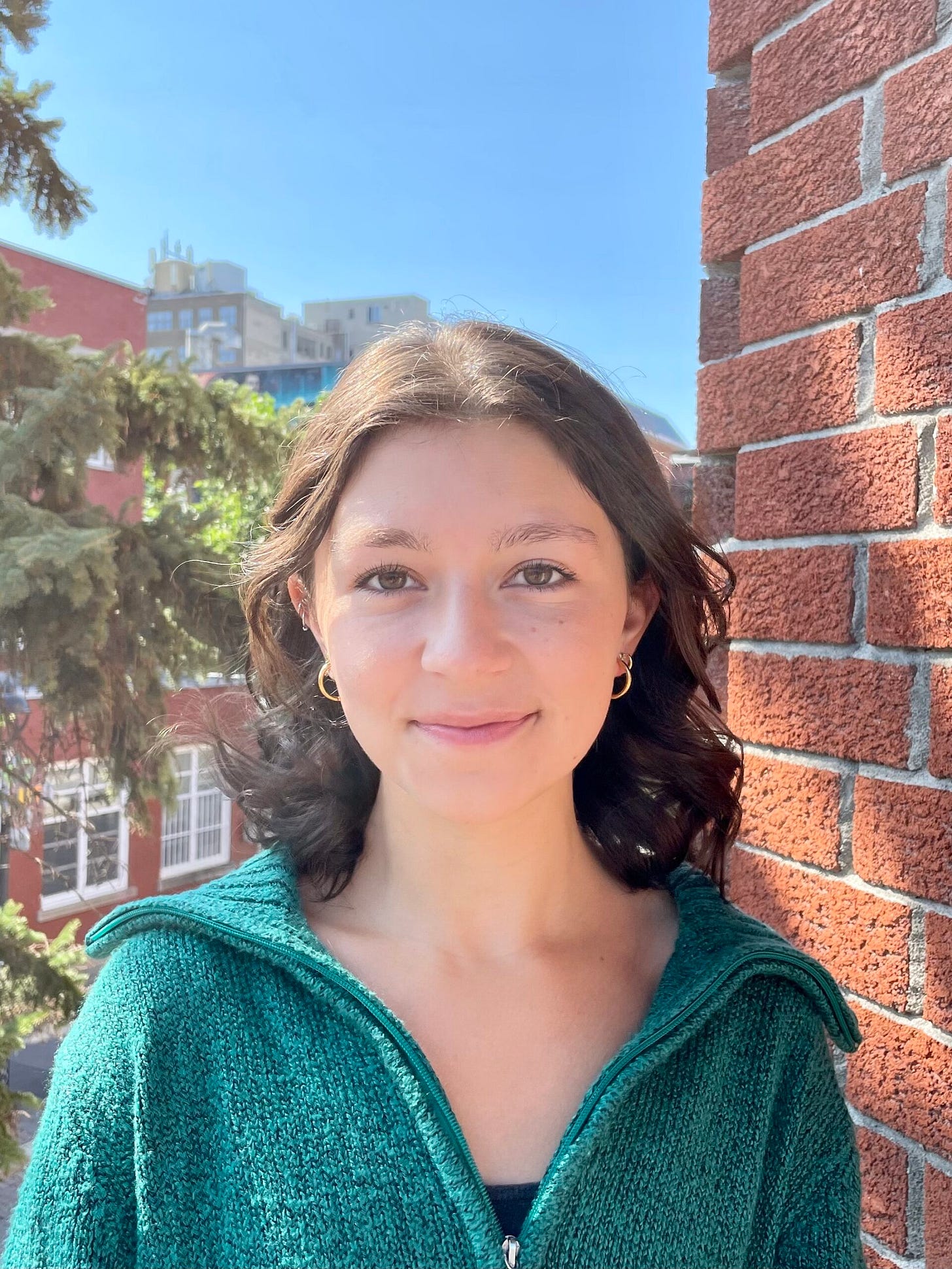
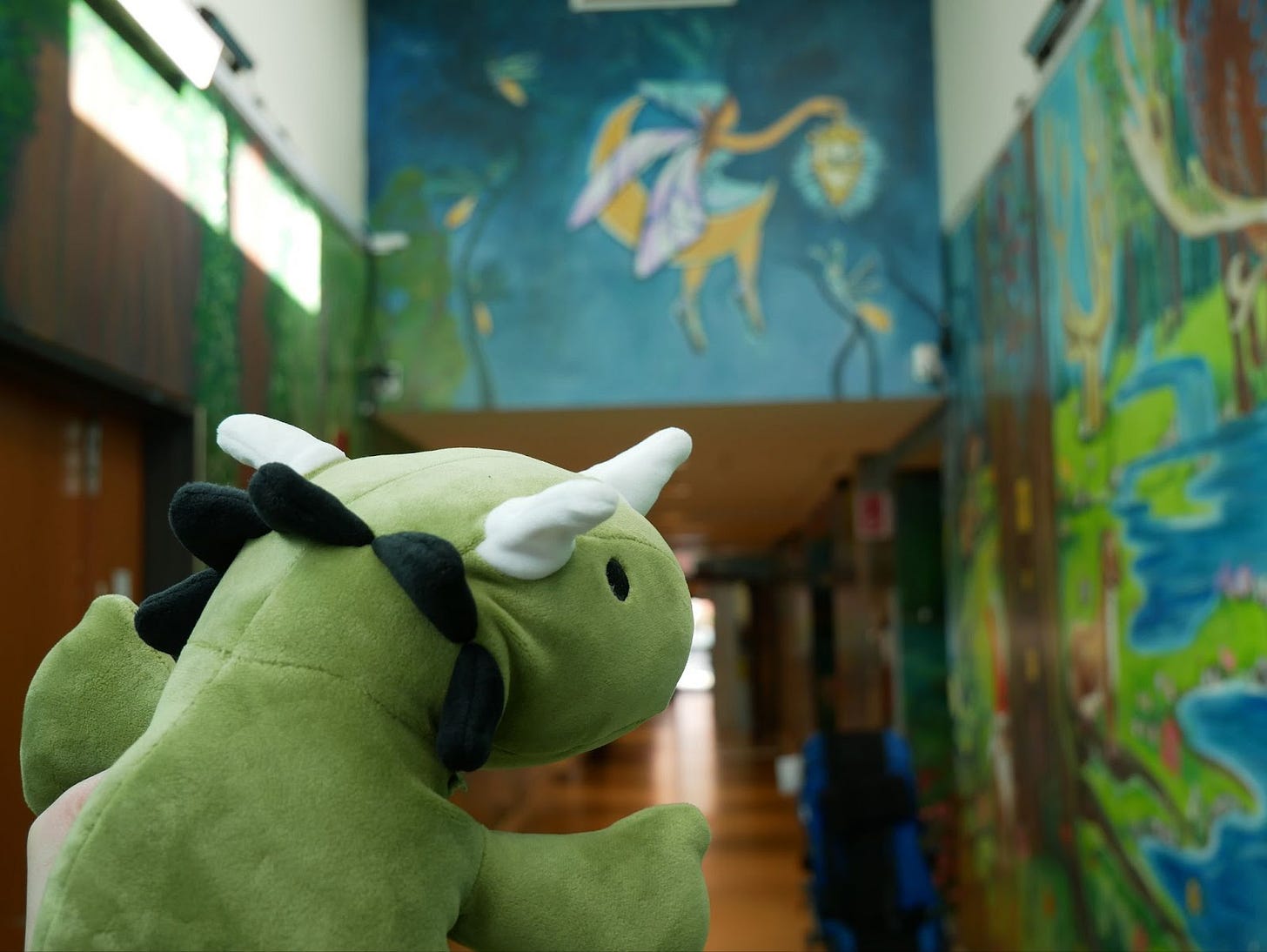
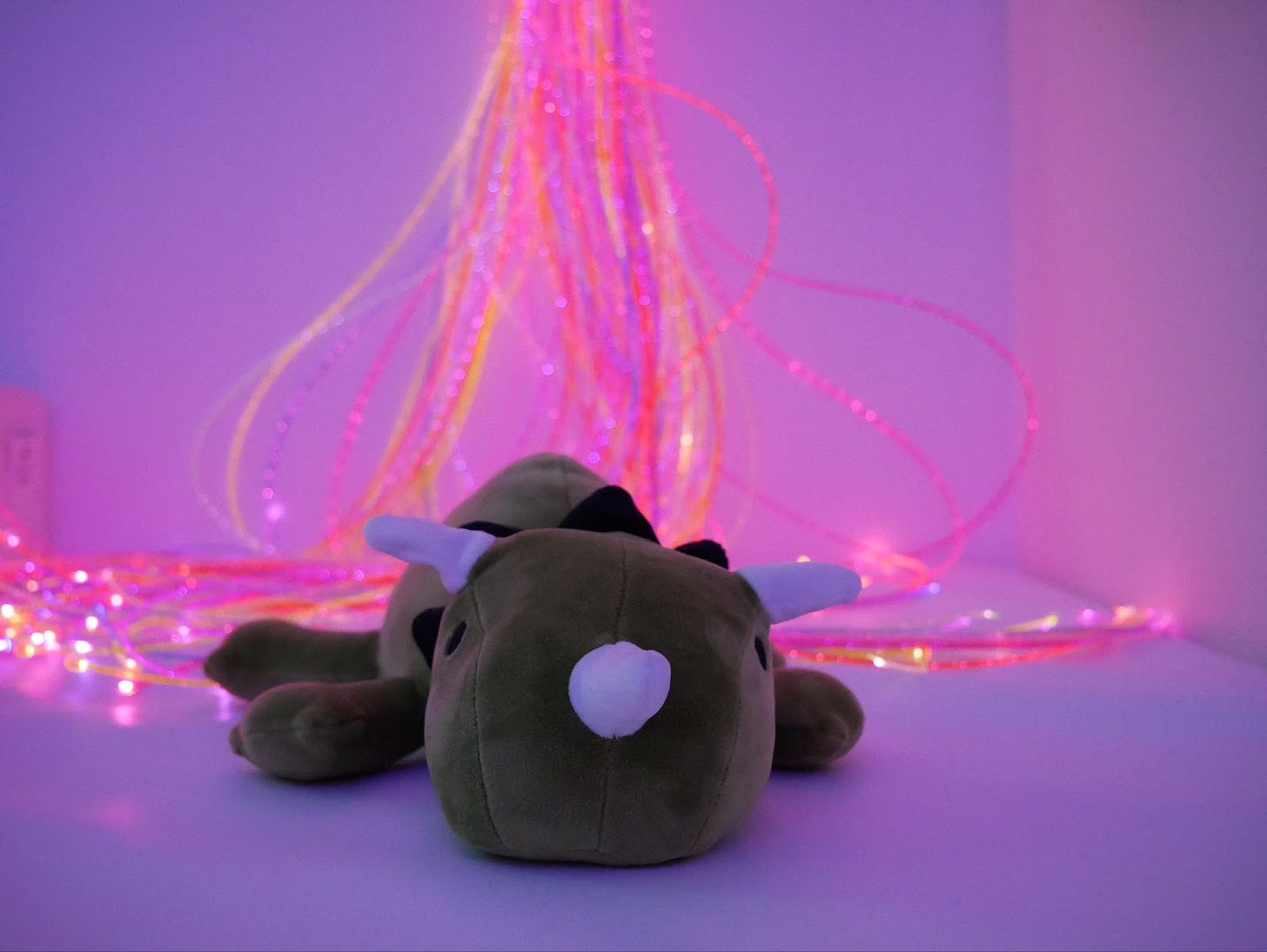
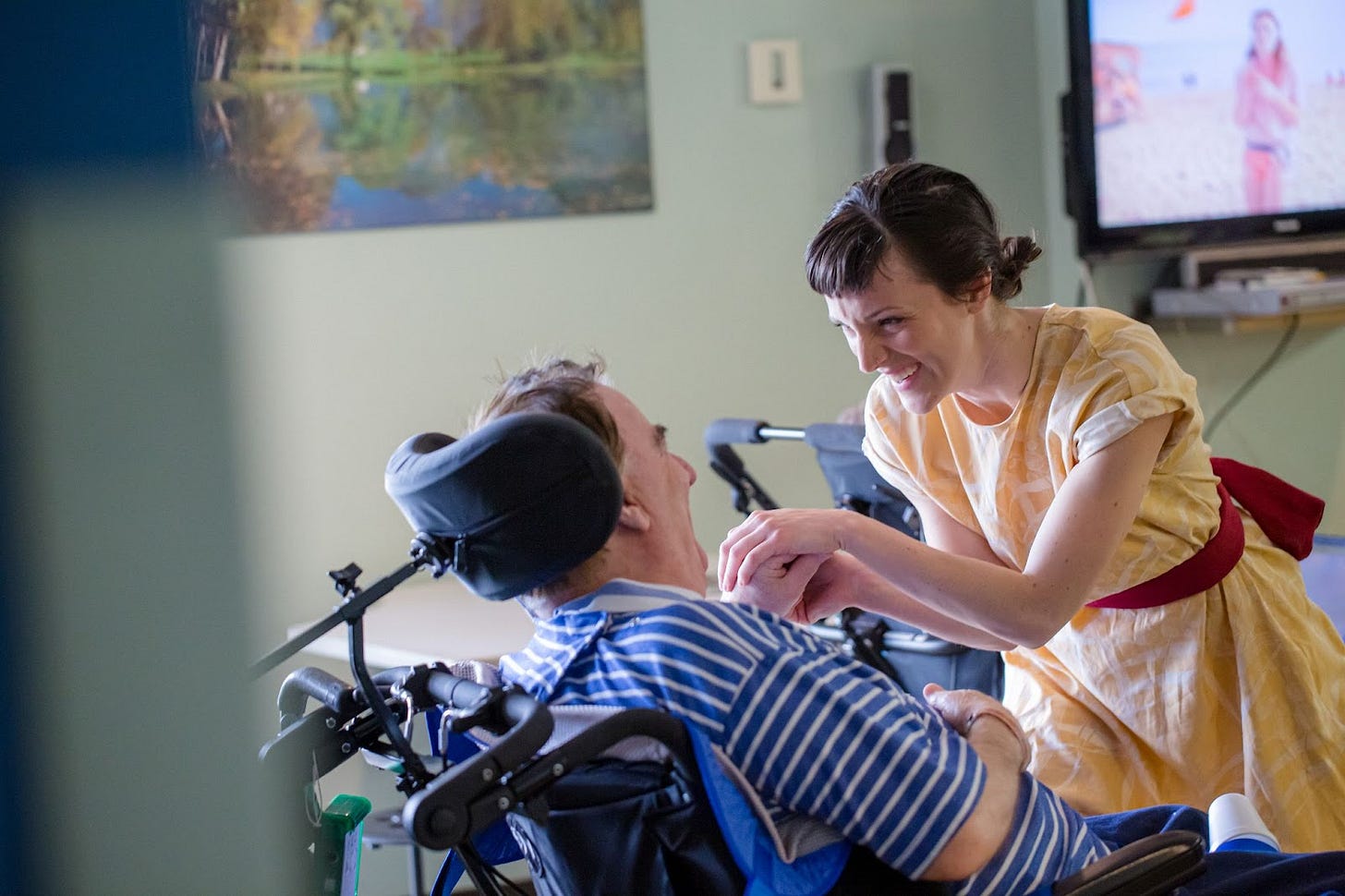
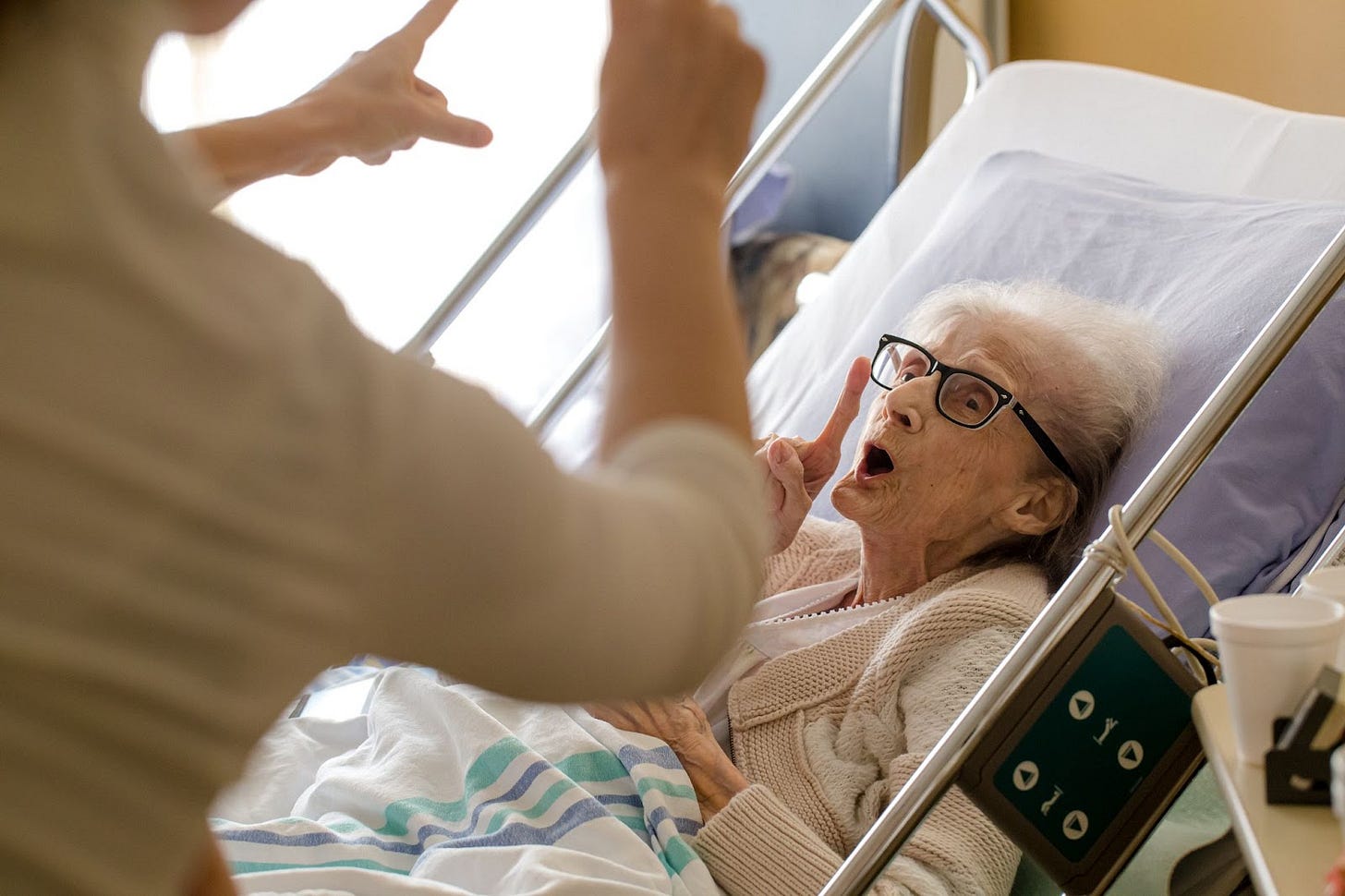
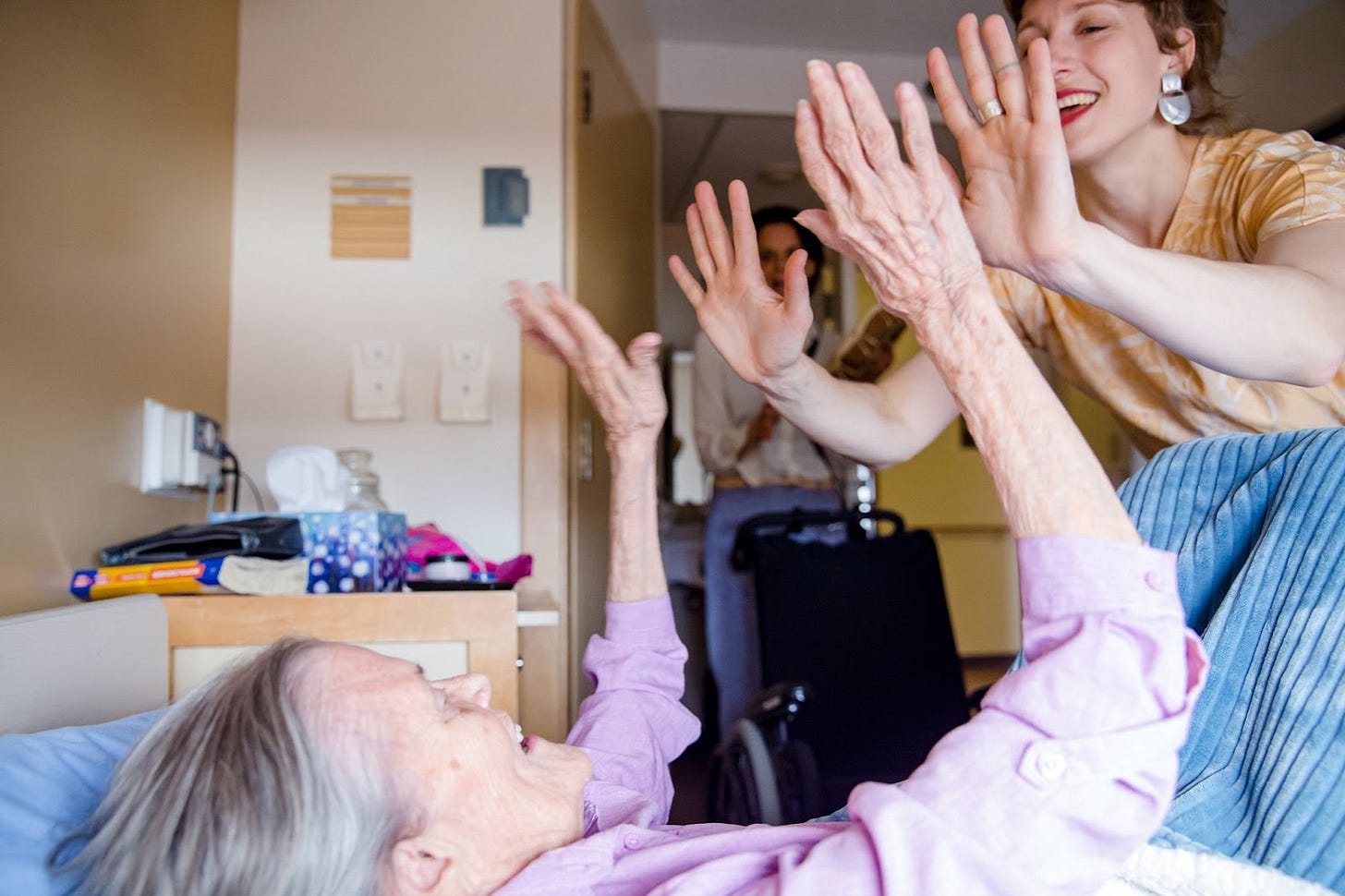


Participatory sensemaking. Situated personhood. Art as relationship. Building relationship through art. Absolute presence of attention. Exquisite sensitivity.
Love this...“Look at that question with respect to someone who's stripped of their ability to contribute to society in a financial way, to contribute their skills - where do they find meaning in life? In the end, it comes down to relationships, comes down to their capacity to be in relationship with others"
And I would add, what do they have to teach us when we stop assuming we are the knowers? What is the message they are bringing to me?
This is all so nourishing to read. These are words that help me to understand more profoundly what I do and what my meaning in life may be.
This one resonates with me personally and professionally from beginning to end, from the way you describe interacting with someone who is dealing with addiction to the poem and 'those near and far'. I appreciate the clear focus on medical practice and how you show that this can be humane and personal without becoming about only that, without becoming a matter of over-interpretation, for example. More and more lately it seems clear PSM is the place to focus and take seriously how bodies make the world in interactions, and how this includes what we mean by mind and feeling as well. It is also uplifting to remember that people are out there trying to help one another, and that this motivation is behind much of our science and academic work.